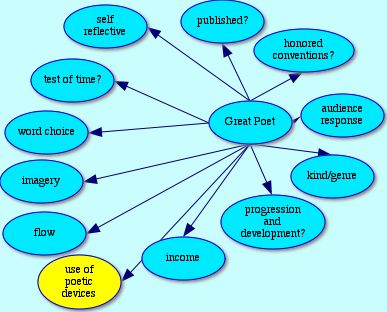
fno.org
|
|
| Vol 18|No 3|January 2009 | |
| Please feel free to e-mail this article to a friend, a principal, a parent, a colleague, a teacher librarian, a college professor, a poet, a magician, a vendor, an artist, a juggler, a student, a news reporter or to anyone else you think might enjoy it. | |
A True OriginalBy Jamie McKenzie, ©2009, all rights reserved.About author With important groups such as ISTE, AASL and the Partnership for 21st Century Skills all calling upon schools to stress originality, imagination and creative production, the meaning of those terms along with related concepts such as synthesis, innovation and invention becomes central to defining the purpose of education. This focus on originality represents a major shift for many schools, classrooms and teachers. It also contrasts dramatically with the draconian methods and measures imposed in the U.S. by the unfortunate and flawed NLCB. This article examines the meanings of the key concepts while considering how they might shape learning in schools during the next decade.
|
 Sunrise in Tokyo with the Tokyo Tower in the distance. © J. McKenzie Is there really "nothing new under the sun?" The New Dictionary of Cultural Literacy, Third Edition. 2002 |
|
A true original? When is a product, a work of art or an idea a true original and when is it a mere copy, a counterfeit or an imitation? When does copying cross the line into plagiarism?
In these times of facsimiles and digital impressions, simulacra will often replace or stand in for what was real.
Beth Orton sings "Reality never lives up to all that it used to be." Later she adds, "The best part of life, it seemed, was a dream." Lyrics from "Best Bit" on her album Pass in Time (2003) How much originality can we expect from our students and how can we best nurture its development? What does originality have to do with ICT? The biggest failing of the past 20 years of ICT (Information and Communication Technologies) in schools has been the putting of carts before the horses, stressing the tools themselves rather than the information, the communicating and the building of new ideas and insight. This is a failure repeated across the culture and the society as fashionable and trendy uses often supersede thoughtful uses. The focus of ICT should be on ways of knowing, learning and understanding, making smart use of information technologies to support exploration and contribute to both comprehension and invention. ICT is about information, understanding and literacy - using thinking skills to make sense of the vast stockpiles of information now available electronically. ICT is about smart thinking, not smart boarding. Degrees of Difference
Who was a better poet? If we ask our high school or university students to compare two poets, we should expect that they do the original thinking involved in such a comparison rather than scooping up the comments of some literary critic or critics.
Sadly, many students might be tempted to rush to the Net and find out what the sages have written on this question. They might soon find themselves reading the following passage from The Cambridge History of English and American Literature:
In this approach to the assignment, the student contents himself or herself with collecting and reporting the opinions of the sages. There is no original thought involved. Original thought might begin with a cluster diagram sketching out the traits of a good poet.
Honoring conventions? Turning them upside down? Being innovative? Being original? Being soothing? Speaking clearly but powerfully? Using rhyme? Writing poetry that withstands the test of time? Being colorful and lyrical? Being inspirational? Ideally, each student will select different traits and each will create a cluster diagram that is unique - one that matches that student's preferences and values.
In comparing the poetic devices (such as alliteration, assonance, imagery and metaphor) employed by Elizabeth and Robert, we should expect students to lay the Brownings' poems side by side. The student might consider several of Elizabeth's Sonnets from the Portuguese such as the 4th drawn from the online collection at http://www.bartleby.com or other sonnets from this site.
Robert's poems can also be found at Bartleby and at this site.
The student should be developing a personal assessment of the power of each poet to capture and express complex ideas and emotions. The assessment should be grounded in terms of literary analysis and substantiated with specific lines and phrases as examples. It would be best if this assessment took place before reading the opinions of the sages. This is not easy work. Gathering the opinions of others is much easier and involves much less analysis. To compare these two poets, the student must consider evidence besides their works.
How Original Thinking Readies Students The kind of thinking suggested above matches that required to score at the Advanced proficiency level on the NAEP Reading Assessment as defined below for 8th Graders:
The Proficient level also requires the reader to build a case and understand literary devices and elements:
How Young? The very young can be challenged to make up their own minds, form their own ideas and create fresh and original possibilities. Original thinking should be thought of as a habit of mind, and primary schools should see their work as engaging students at the fourth level of the Degrees of Difference outlined above - Starting Fresh. In fact, the work properly begins in pre-school, as good teachers engage the very young in tasks that invite imagination, play, improvisation and wonder. Note article "In the Early Years." This charge is well understood in New Zealand where the early childhood curriculum is clear about the importance of such themes. Note article "The Early Childhood Workshop."
|
|
|
Copyright Policy: Materials published in From Now On may be duplicated in hard copy format if unchanged in format and content for educational, nonprofit school district and university use only and may also be sent from person to person by e-mail. This copyright statement must be included. All other uses, transmissions and duplications are prohibited unless permission is granted expressly. Showing these pages remotely through frames is not permitted. |
|



 The student must wrestle with some difficult concepts. Does popularity matter? Income? Being widely published? Creating new possibilities for poetry? Sticking with the tried and true?
The student must wrestle with some difficult concepts. Does popularity matter? Income? Being widely published? Creating new possibilities for poetry? Sticking with the tried and true?  This approach to the assignment then charges the student with the responsibility of collecting data to build a case.
This approach to the assignment then charges the student with the responsibility of collecting data to build a case.